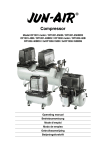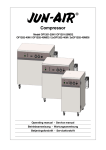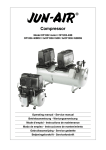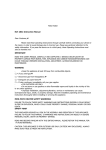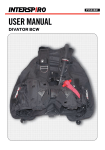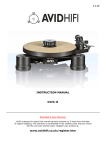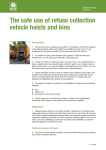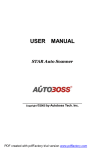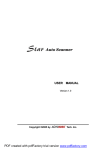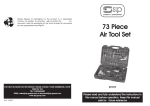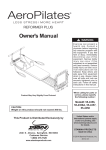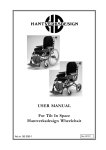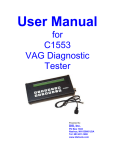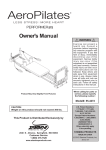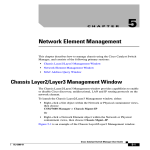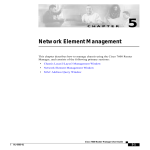Download Neptune Pool Lift User Manual
Transcript
Poollift Neptune with Transporter Operating and Product Care Instructions Doc.:065 Rev.: 0 Datum: 26/11/2012 Thank you for purchasing equipment. Nibotechncis Your POOL LIFT is one of a series of quality products designed especially for hospitals, nursing homes and other health care environments. Please contact your local distributor if you have any questions about the operation or Nibotechnics maintenance of your equipment. All references to ‘the resident’ in these instructions refer to the person being lifted, and references to ‘the caregiver’ refer to the person who operates the POOL LIFT. References to left and right of the lift in these instructions are as viewed when you are standing at the rear of the POOL LIFT, facing forward, (as viewed from the caregiver’s pushing position). Lifting operations in these instructions are described as if lifting a resident from a chair. The same operations can be performed effectively when lifting a resident from a wheelchair or sitting position on a stretcher, although a second caregiver should support the resident if the resident lacks sitting balance. Operational Life The operational life of the POOL LIFT and its accessories e.g. stretcher, etc. is dependent on the actual use conditions. Therefore, before use, always make sure that the lift is safe to use and has not been damaged (see Preventive Maintenance Schedule at the end of this document for details). If any damage should be observed, do not use the POOL LIFT. Contents SECTION Safety Instructions Product Description/Function Parts referred to in this manual POOL LIFT: maximum capacities POOL LIFT resident transporters Using Your POOL LIFT Transferring to pool side with chair Transferring to pool side using the stretcher Attaching the chair or stretcher to the POOL LIFT Transfer to the pool Transfer out of the pool Product description/function Parts referred to in this manual Using your POOL LIFT Transporter Preparation of POOL LIFT Transporter Care of your POOL LIFT & Transporter Labels Technical specifications Preventive Maintenance Schedule Doc.: 065 Rev.: 0 3 Page No. 4 5)6 5 6 6 7-10 7 7 7-8 9 9-10 11 11 12 13-14 15 16 17-23 24-27 Datum: 26/11/2012 Safety Instructions • is dependent on caregiver who is present in demanding situations POOL LIFT can be used to lift a person, who: READ BEFORE USE Before using your POOL LIFT, familiarize yourself with the various parts and controls as illustrated in this document. Read this whole manual thoroughly before operating your POOL LIFT, in order to prevent injury or damage to the product. Definitions used in these instructions: • • • • sits in a wheelchair can partially bear weight on at least one leg has some trunk stability is dependent on caregiver in some situations POOL LIFT can be used to lift a person, who: • Sits in a wheelchair • no capacity to support herself • is dependent on caregiver in most situations POOL LIFT shall always be handled by a trained caregiver who will care for the resident in accordance with these Operating and Product Care Instructions. WARNING Means: failure to follow these instructions may result in injury to yourself or to others. WARNING CAUTION Means: failure to follow these instructions may cause damage to the product(s). INTENDED USE The POOL LIFT Neptune is a stationary lift that has to be mounted in- or onto the Poolside floor before resident transfer. It has been designed to transfer residents from the poolside into the pool and the other way around, using a chair or stretcher that has been specially designed for the POOL LIFT. The POOL LIFT has been designed to lift a person, who: A clinical assessment should be carried out by a qualified nurse or therapist before lifting residents for suitability of transfer in the POOL LIFT e.g. residents who have curvature of the spine or who are subject to muscle spasms, or other residents, may not be suitable. During resident transfer to and from the water, two caregivers are present. One to operate the lifter and the other to assist the resident at all times. Extra care should be given during resident transfer from the water when both resident and seat are wet. GENERAL SAFETY INSTRUCTIONS Only use Nibotechnics chairs, transporting equipment and stretchers that have been specifically designed for the POOL LIFT. • is mobile, but may use a cane for support • is independent, can clean & dress himself • can tire quickly POOLLIFT can be used to lift a person, who: Do not overload the POOL LIFT beyond the approved lifting capacity (See page 6). • uses a walking frame or similar • can support herself to some degree Do not manually lift the complete lifter but use the transporter for all transfers. WARNING Insert the support column correctly into the column location socket /base plate. Doc.: 065 Rev.: 0 4 Datum: 26/11/2012 Product Description/Function Parts referred to in this manual 1 2 3 16 5 4 15 6 14 7 11 8 9 12 13 10 Fig. 1 1. Mast 9.Footrest 2. Boom 10. Braked castors 3. Chair handle and hook up bar 11. Support column 4. Chair / Stretcher retaining catch 12. Column location socket 5. Fold back arm rest 13. Base plate 6. Sliding leg rest 14. Base cover 7. Left prong with chair catch 15. Rotation lock 8. Detachable sub-chassis 16. Winding handle Doc.: 065 Rev.: 0 5 Datum: 26/11/2012 Product Description/Function POOL LIFT: Maximum capacities Toilet / Commode / Shower Chair (TCS) POOL LIFT (Socket or Base plate mounted): The chair, which can be attached to / detached from the POOL LIFT, has a removable subchassis. Only the chair is to go into the pool. Leg rest available. Toileting facility (See Fig. 4). • fitted with standard boom: - 680 mm - 160 kg (352 lbs) • fitted with boom: - 1000mm - 160 kg (352 lbs) Hook up point ‘Fold back’ arms • fitted with boom: - 1200mm - 127 kg (280 lbs) Detachable commode attachment The capacities may differ, depending on the type of boom. Inform yourself on the correct capacity by reading the label fixed to the main column housing, below the winding handle. POOL LIFT Resident Transporters: Footrest The operation of the resident transporter units may differ, depending on the type selected. Fig. 4 To help prevent the accidental release of the chair, a retaining catch is fitted to the left hand ‘prong’ of the sub-chassis. When the chair is pushed onto the chassis, the catch connects with a slot in the chair frame tube (see Fig. 10). Press the catch in to remove the chair. Swimchair ‘Fold back’ arms Braked castors Hook up point Stretcher Unit The stretcher can be detached from the POOL LIFT, but only the resident platform is intended to go into the pool (See Fig.5). Braked castors Footrest Fig. 2 Adjustable backrest Hook up point Resident platform Detachable from the POOL LIFT, but the whole unit is lowered into the pool. This unit may be detached from the POOL LIFT once in the water and lowered securely onto the pool floor, providing that the water depth is correct for the resident (See Fig. 3). Stretcher trolley Braked castors Fig. 5 WARNING Avoid any part of the resident’s or caregivers body coming between parts of the lifter that join together or touch during operation e.g. when attaching seat or stretcher to mast etc. Fig. 3 Doc.: 065 Rev.: 0 6 Datum: 26/11/2012 Using your POOL LIFT Neptune Transferring to Poolside with chair WARNING The chair arms fold back for easy resident access. Once the resident is suitably dressed for swimming, transfer him/her into the chair (swimchair or TCS). To lower the stretcher, hold the backrest and lift it slightly, then lift up the ratchet position plate by holding either of the ratchet plate knobs ONLY (See inset to fig. 10). WARNING If the resident is unstable or restless, the safety rail may be used to protect the resident on the stretcher. Always ensure the brakes are on during transfer onto and of the chair. Attaching the chair or stretcher to the POOL LIFT Ensure the arm rests are folded forward, encircling the resident for safety during transfer. Rotate the POOL LIFT away from the pool. Never leave the resident unattended. Turn the rotation lock anti-clockwise to rotate (turn clockwise to lock) (See Fig. 7). Always work according to good bathing principles e.g. check water temperature, water depth, care of the resident, etc. Fig. 7 Fig. 6 The TCS chair may be used over a toilet if necessary, when going to or from the poolside. Use the brakes when over a toilet (See Fig. 6). WARNING Make sure that the rotation lock is on desired position. Transferring to Poolside using the Stretcher The resident may be taken to the pool from bedside or from another stretcher by using the stretcher/trolley unit. Transfer the resident by sliding or rolling as appropriate. To adjust the backrest when the resident is on the stretcher, firstly support the resident clear of the backrest, then carry out the adjustment. (A second person may be required for this operation). To make the back more upright, simply lift up to the Doc.: 065 Rev.: 0 7 Datum: 26/11/2012 Using your POOL LIFT Neptune before attaching the chair or stretcher. Reverse the chair unit or bring the stretcher, sideways on, towards the POOL LIFT mast until the top of the support frame comes into the close proximity of the mast. WARNING Adjust the height of the mast so that the hook up bar (with retaining catch) can be positioned under the top of the chair or stretcher support frame. The top of the support frame must be firmly attached to the hook up bar and the retaining catch must have operated to hold the frame tube (See Fig. 8). Doc.: 065 Rev.: 0 8 Datum: 26/11/2012 Using your POOL LIFT Neptune chair tube Fig. 8 Raise the mast so that the chair wheels are clear of the ground. If you have a TCS chair, remove the subchassis. To help this action, take the resident’s feet off the foot rest by using the leg rest if desired. Operate the catch, situated under the left side of the seat, and gently move the sub-chassis backwards until free (See Fig. 9). Sub-chassis fork (LH) Fig. 9 To move the stretcher away from its trolley after hook up to the POOL LIFT, lift the lever situated at the foot end of the trolley. Check if the mast catch works, then raise the POOL LIFT mast (See Fig. 10). Guide tube Release lever to separate stretcher from trolley Doc.: 065 Guide tube Ratchet plate knobs Rev.: 0 9 Resident back support adjustment Fig. 10 Datum: 26/11/2012 Using your POOL LIFT Neptune Transfer to the pool After the resident has been received by the helper in the pool, remove the mast from the water or return to repeat the procedure for the next resident. Release the POOL LIFT rotation lock (See Fig. 1) by turning anti-clockwise. WARNING Raise the resident sufficiently to clear the pool edge (raised edge poolsides only) (See Fig. 11). There should always be someone at the poolside competent to operate the POOL LIFT while the resident(s) is in the water. Fig. 11 Transfer out of the pool WARNING Fold back the chair arms, then lower the chair or stretcher into the pool to the same depth as before. The helper should put the resident in the chair or stretcher and fold the encircling arm rests on the chair back around the resident or if using the stretcher, put the safety rails around the resident if required. If using the Swimchair and it has been removed from the POOL LIFT mast in the pool, ensure it is correctly connected to the mast and that the chair retaining catch has operated before returning the resident to the chair. For sunken pools, raise the resident so that the chair or stretcher sufficiently clears any obstruction. WARNING Avoid any part of the resident’s or caregiver’s body coming between parts of the lifter that join together or touch during operation e.g. when attaching seat or stretcher to mast etc. Ensure there is someone in the pool ready to help the resident into the water. Move the resident over the pool by pushing sideways on the boom, until the desired position is reached. When resident and helper are ready, raise the resident from the pool until high enough to clear the poolside. WARNING Engage the rotation lock firmly. Lower the resident until deep enough in the water, indicated by the helper in the pool (usually mid-chest). If the resident is on a stretcher with the shoulders raised, the water should come to shoulder level to improve buoyancies. Fold back the chair arm rest(s) to get resident access, if required. Fig. 12 Doc.: 065 Rev.: 0 10 Datum: 26/11/2012 Using your POOL LIFT Neptune Release the rotation lock and rotate back over the pool side by pulling the boom towards you. When in position for transfer, engage the rotation lock. If you need to use the TCS chair, raise the seat sufficiently high enough above the floor and insert the prongs of the sub-chassis unit into the chair frame tubes (see Fig. 9) until the retaining catch works and locks. Begin to lower the mast and at the same time open the chair retaining catch on the mast, just before the wheels of the sub-chassis contact the floor. Continue to lower the mast, keeping the chair retaining catch open, until the chair frame tube is clear of the hook up point. Push the chair away from the POOL LIFT, apply the brakes and prepare the resident for return to the changing room. When using the stretcher, position the stretcher trolley so that the stretcher can be lowered directly onto it, ensuring that the guide tubes on the stretcher trolley are in the position as shown in Fig. 10. Continue lowering, having opened the chair / stretcher retaining catch, until the stretcher connects with the locking catch on the trolley. Continue lowering until the hook up point is completely clear of the stretcher hook up tube. WARNING Ensure the brakes are applied whenever the trolley is not being moved. To unhook the stretcher unit from the mast, push in the retaining catch lever on the mast and continue to lower the mast until the stretcher is clear of the hook up point. Release the trolley brakes and return to the changing room. Doc.: 065 Rev.: 0 11 Datum: 26/11/2012 Product Description/Function Transporter Parts referred to in this manual 1 2 4 3 7 5 6 8 9 1. Winding handle 4. Guide roller 7. Clamps 2. Mast 5. Guide 8. Brake 3. Triangular steady 6. Brake 9. Chassis 11 Fig. 13 Using your POOL LIFT Transporter When this distance has been measured and referring to Fig. 14, continue to fit the triangular steady into the chassis. First, position one of the location pegs into its hole (See Fig. 16) Fig. 16 Then carefully pull back the frame by applying slight pressure, just enough to allow the other peg to clear the chassis leg and insert into its hole (See Fig. 17). Fig. 14 Before using your Nibotechnics POOL LIFT Transporter, it will have to be assembled as follows: Remove the three major components (See Fig. 13) from their packaging. Remove and hold the screw from the lower end of the mast using the key provided. Carefully slide the mast into the chassis centre socket (See Fig. 14). It can only go in one way. Insert the screw through the chassis socket and tighten into the mast using the key (See Fig. 15). Fig. 17 The steady should move freely and the plastic covered stops will allow it to rest on the chassis in the operational position (See Fig. 18). The fitting position of the triangular steady depends on the POOL LIFT boom length. Before continuing with your assembly, determine which boom length is fitted by measuring the distance referred to in Fig. 17. Also read the preparation of the POOL LIFT Transporter on pages 14-15. Fig. 18 Your POOL LIFT Transporter is now ready for use. Fig. 15 12 Using your POOL LIFT Transporter Preparation of POOL LIFT Transporter The triangular steady (See Fig. 13) of the Transporter can be fitted in three separate positions. Each position is intended for the different boom lengths that can be supplied with the Nibotechnics POOL LIFT. Before attempting to use the Transporter, ensure the steady is fitted in the correct position on the Transporter, relative to the boom length of the POOL LIFT to be lifted (See Fig. 19). Fig. 20 Remove the chair or stretcher from the POOL LIFT and move the boom (1) in Figs. 21 and 22 away from the pool edge, (See Fig. 21), lower the mast (2) to within 150mm (6”) of the ground level. If after referring to Fig. 19 and measuring the POOL LIFT boom, the triangular steady is found not to be in the correct position, it can be easily repositioned as follows: Temporarily pull back one of the steady side members (See Fig. 20) to pull out the pivot peg from its hole. Pull out the other frame peg and take the ‘steady’ away from the chassis. Reposition the frame referring to Fig. 19, reversing the above procedure. 680 mm (263/4) Standard Boom Triangular Steady Position ‘A’ 1000 mm (395/8) Boom Position ‘B’ 1200 mm (471/4) Boom Position ‘C’ Fig. 19 13 Using your POOL LIFT Transporter Position the clamp section of the Transporter at its lowest position by turning the winding handle (3) anti-clockwise. POOL EDGE Open the clamps (4) and approach the POOL LIFT as shown in Fig. 21. 8 4 Engage the guide (5) with the POOL LIFT column (6). 5 Lift the triangular steady (7) and rotate the POOL LIFT boom (1) until it is in line with the guide roller (8) on the steady. 3 7 Lower the steady until the roller engages in the slot in the mast. Lock the Transporter brakes (9) and secure the clamps (4) so they firmly grip the POOL LIFT column (but are not overtight). 1 Fig. 21 Tighten the POOL LIFT swivel clamp (10). Operate the winding handle (3) in a clockwise direction to raise the POOL LIFT from its socket. If the POOL LIFT is tightly held in the socket, a slight rocking action should free it enough to be lifted out. 1 When the column is clear of ground level, release the Transporter brakes and move the Transporter, with the POOL LIFT securely attached, carefully away. 10 8 3 7 To re-install the POOL LIFT, reverse the above procedure. 6 CAUTION 5 2 Do not operate the winding handle (3) while the POOL LIFT is held in the Transporter. Chairs / stretchers must not be attached to the POOL LIFT while mounted on the Transporter. 9 4 Fig. 22 14 Care of your POOL LIFT & TRANSPORTER For cleaning your POOL LIFT, wipe down with a damp cloth using warm water to which a mild detergent has been added. Environmental advice When disposing of any items associated with the lifter, contact the appropriate local authority for advice. For information on the maintenance instructions of your POOL LIFT and TRANSPORTER, direct yourself to the Preventive Maintenance Schedule in the back of this manual. CAUTION Do not use petroleum based solvents or similar, as these may damage plastic parts. WARNING If in any doubt about the correct functioning of the POOL LIFT, withdraw it from use and contact the distributor. UK LIFTERS ONLY: Important legislation came into force on 5th December 1998, which has an impact on the schedule of service for your patient lifter(s), variable height baths and other raising and lowering equipment. The Lifting Operations and Lifting Equipment Regulations (LOLER) 1998 and The Provision and Use of Work Equipment Regulations (PUWER 98) must be satisfied by the duty holder. A scheme of six monthly through examinations has been devised to comply with the law and details can be obtained from the distributor UK. Spare parts, if required are available from Nibotechnics or their approved distributors. Special tools are required for certain component replacement. The simplest; safest and most effective way to maintain your product in good working order, is to have it methodically and professionally serviced by the distributor approved engineer using Nibotechnics approved spare parts. For information on service and maintenance contracts, please contact your local distributor. 15 Labels 1 2 3 Fig. 23 1+2. Attention: Read Operating Instructions 3. Safe Working Load: Dependent on Boom size / Serial Number 16 Technical Specifications Component Weights Kg Lbs POOL LIFT Minimum weight (average).....................................................................70 Maximum weight (average)....................................................................85 154,32 187,39 Maximum Lifting Capacities Basic lift with a boom of 680 mm...........................................................160 Basic lift with a boom of 1000 mm.........................................................160 Basic lift with a boom of1200 mm .........................................................127 Depth of Socket below floor 300 795 1310 305 POOL LIFT STANDARD COLUMN 17 352,74 352,74 279,99 Technical Specifications COMMODE CHAIR & SUB-CHASSIS 500 mm Seat width 360 mm 1040 mm 495 mm 820 mm 450 mm This is available in: AA1070 Chassis 450 with footrest AA1071 Chassis 475 with footrest AA1072 Chassis 500 with footrest AA1073 Chassis 525 with footrest AA1075 Chassis 450 with footbar AA1077 Chassis 450 footbar + S/S Stems AA1078 Chassis 450mm ft/rest + S/S Spin- 450 mm 145 mm 750 mm 495 mm 18 Technical Specifications SWIMCHAIR 415 mm 400 mm POOL LIFT TRANSPORTER Standard mast 1722 mm 200 mm Approx. above floor 680 mm 1200 mm 19 Technical Specifications UPPER VIEW POOL LIFT WITH STRETCHER UNIT Stretcher POOL LIFT Head end Stretcher Stretcher swing rads. std boom = 190 cm 1 metre boom = 222 cm 1.2 metre boom = 242 cm POOL LIFT WITH CHAIR UNIT, WITH AND WITHOUT LEG REST POOL LIFT CHAIR Chair swing rads. std boom = 150 cm 1 metre boom = 182 cm 1.2 metre boom = 202 cm 20 Chair and leg rest swing rads. std boom = 200 cm 1 metre boom = 232 cm 1.2 metre boom = 252 cm Technical Specifications POOL LIFT POSITION A SOCKET MOUNTING 800 mm REF 1000 mm REF floor covering screed Mounting socket Epoxy. Resin grout Reinforced concrete Grade 35n/MM2 (5000 IB/IN2) Check for services & ducts in locality of proposed foundations Dimension ‘A’ 50 mm minimum recommended clearance between handrail & mast. If handrail not provided, 50 mm clearance applies from extreme edge of pool to mast or any other obstruction. Dimension ‘B’ 350 mm minimum distance from edge of wall to centre line of column applies only when height of wall is maximum of 1000 mm Dimension ‘C’ 250 mm minimum when screed is at 75 mm max for a minimum radius of 600 mm in all directions. Hole size for mounting socket, diameter 1.30 mm, depth 285 mm 21 Technical Specifications GENERAL MEASUREMENTS Raised pools and therapy tanks Boom position A Deck level pools Boom position B Minimum roof height Minimum roof height 2810 mm (110.5 in) 2340 mm (92 in) 800mm (31.5 in) 800 mm (31.5 in) 1100 mm (43.5 in) 1270 mm (50 in) Stroke Mast length 1735 mm (68.3 in) 615 1075 680 1100mm 43.5 in Floor level 290 mm (11.4 in) 1140 1270 mm (50 in) Stroke 590 Floor level 130 1900 swing radius 1900 swing radius Space requirements with standard boom (800 mm) Alternative boom length Radius of swing with chair unit 1500 mm (59 in) Radius of swing with stretcher 1900 mm (75 in) Radius of swing with chair and leg rest 2000 mm (79 in) 1 metre (add 320 mm (12”) to swing radius) 1.2 metres (add 520 mm (21”) to swing radius Difference between underside of stretcher and end of mast 22 Technical Specifications POOL LIFT STRETCHER 1550 fully in position +100 To disengagement stretcher from trolley 2000 fully extended 600 1175 1075 Pick up 685 1065 930 740 640-620 325 RUN OFF 940 375 125 mm wheels STRETCHER TROLLEY - OVERALL DIMENSIONS 520 mm 378 mm 990 mm 744 mm 1405 mm 23 Preventive Maintenance Schedule The POOL LIFT is subject to wear and tear, and the following actions must be performed when specified to ensure that the product remains within its original manufacturing specification. WARNING The points on this checklist are the minimum the manufacturer recommends. In some cases due to heavy use of the product and exposure to agressive environment, more frequent inspections shall be carried out. Continuing to use this product without conducting regular inspections or when a fault is found will seriously compromise the user and residents’ safety. Local regulations and standards may be higher than the manufacturers. Preventive maintenance specified in this manual can prevent accidents. The parts which are entitled ‘Checks to be performed by Qualified distributor personnel’ have to be carried out by qualified personnel, using correct tools and knowledge of procedures. Failure to meet these requirements could result in personal injuries and / or unsafe product. Preventive Maintenance Schedule Before each use Action/Check Every day Every Week Every Every 6 months 12 months Nibotechnics Toilet / Commode / Shower chair Visually inspect the sub-chassis to make sure the castors and footrest are securely attached before use X Examine all exposed parts, especially where there is personal contact with the patient’s body. Make sure no cracks or sharp edges have developed that could cause patient or user injury or have become unhygienic. Replace where necessary. X Make sure all external fittings are secure, and all screws and nuts are tight. X Check that the swimchair / TCS sub-chassis / stretcher unit can be propelled in a normal manner, making sure that the castors are quite free in their movement Carry out decontamination of the Sub- chassis, Seat and Frame in accordance with the Operating Instructions and local regulations. X Make sure all instruction labels are firmly attached and are readable. See Operating Instruction for location of labels. X Make sure all 4 off castors rotate freely, are securely fitted into the frame and the brakes lock. Also check the castor tread for damage. X Make sure the safety catch, locking the seat frame to the sub-chassis operates freely. X Make sure the seat and backrest are securely attached to the frame. X CHECKS TO BE PERFORMED BY QUALIFIED Carry out the Weekly Preventive Maintenance Schedule checks plus the following: Check the torque value on the castor inserts 12 Nm (8.8 lbf ft) Nibotechnics trained PERSONNEL X Carry out a full inspection of the chair, checking welded areas for cracks, corrosion and the general condition of the chair. Replace those components where required. X 24 Every 2 years Preventive Maintenance Schedule Nibotechnics Swimchair Visually inspect the chassis to make sure the castors and footrest are securely attached before use. X Examine all exposed parts, especially where there is personal contact with the patient’s body. Make sure no cracks or sharp edges have developed that could cause patient or user injury or have become unhygienic. Replace where necessary. X Carry out decontamination of the Nibotechnics Swimchair in accordance with Nibotechnics Operating Instructions and local regulations. X Make sure all instruction labels are firmly attached and are readable. See Operating Instruction for location of labels. X Make sure all external fittings are secure, and all screws and nuts are tight. X Make sure all 4 wheels rotate freely, are securely fitted into the frame and the 2 off rear castor brakes lock. X CHECKS TO BE PERFORMED BY QUALIFIED Nibotechnics trained Carry out the Weekly Preventive Maintenance Schedule checks. PERSONNEL X Carry out a full inspection of the chair, checking welded areas for cracks, corrosion and the general condition of the chair. Replace those components where required. X Nibotechnics Stretcher and Trolley Make sure the mattress is securely attached to the stretcher platform using the Velcro strips. X Make sure the stretcher is correctly positioned on the trolley and locked in place X Make sure the adjustable backrest lock is fully engaged in the slot. X Carry out decontamination Stretcher and Trolley. of the Nibotechnics X Make sure all instruction labels are firmly attached and are readable. See Operating Instruction for location of labels. X Make sure all external fittings are secure, and all screws and nuts are tight. X Make sure all 4 wheels rotate freely, are securely fitted into the frame and the 2 off castor brakes lock. X Make sure the release lever, allowing separation of the stretcher from the trolley, moves freely. X Where an additional guard-rail is used, make sure the spring clip is attached to a chain and locates locking the guard-rail in place satisfactorily. Replace if required. X Check the condition of the patient platform on the stretcher frame, making sure it is not cracked, loose, the Velcro is firmly attached etc. Replace as necessary. X CHECKS TO BE PERFORMED BY QUALIFIED Ni b ot ec h ni cs Carry out the Weekly Preventive Maintenance Schedule checks. t r ai ne d PERSONNEL X Carry out a full inspection of the stretcher and trolley, checking welded areas for cracks, corrosion and the general condition of the stretcher and trolley. Replace those components where required. X 25 Preventive Maintenance Schedule Nibotechnics POOL LIFT Transporter Check the condition and bond of the clamp pads and for free movement of the clamps. X Check for smooth operation of the lifting mechanism. X Make sure that castors are free in their movement and that the brakes operate efficiently. X Make sure that all external fittings are secure and that screws and nuts are tight. X Make sure that all safety labels are firmly attached and in good condition. Replace as necessary. See Operating Instruction for location of labels. X CHECKS TO BE PERFORMED BY QUALIFIED Nibotechnics trained Carry out the Weekly Preventive Maintenance Schedule checks. PERSONNEL X Carry out a general visual inspection of all external parts to make sure no adverse damage/wear has occurred. Replace components where necessary. X Clean and re-grease winding shaft using Energrease FG 00-EP or equivalent. X Clean and re-grease clamp-screws and hinge-pins using silicone grease or equivalent. X On the guide wheel frame make sure the guide wheel rotates freely and lubricate using silicone grease or equivalent as required. X Nibotechnics POOL LIFT After use each day, wash the POOL LIFT and resident transporters with fresh water (not pool water) and wipe dry. If the POOL LIFT has not been used and is stored in a pool side atmosphere, then periodically wash it down with fresh water and wipe dry, as pool side atmospheres can be corrosive. X Make sure the chair / stretcher retaining safety catch on the traveller operates correctly and that the spring pressure within the catch is maintained. X Examine all exposed parts, especially where there is personal contact with the patient’s body. Make sure no cracks or sharp edges have developed that could cause patient or user injury or have become unhygienic. Replace where necessary. X Carry out decontamination of the Nibotechnics POOL LIFT in accordance with Nibotechnics Operating Instructions and local regulations. X With the seat in the fully lowered position, visually examine the exposed lifting cable within the mast for any signs of damage. If the lifting cable is damaged in any way the POOL LIFT must not be used until the lifting cable is replaced. X Make sure all external fittings are secure and all screws and nuts are tight. X Fully raise and lower the seat and jib using the winding handle to check for full and satisfactory movement. X Make sure all instruction labels are firmly attached and are readable. Replace as required. See Operating Instruction for location of labels. X Check the mast rotation lock to ensure that it locks and releases satisfactorily X 26 Preventive Maintenance Schedule CHECKS TO BE PERFORMED BY QUALIFIED Nibotechnics trained PERSONNEL Visually inspect the wire rope assembly for signs of corrosion, fraying and wear etc by removing the cover from the housing. Once removed, visually inspect the rope whilst operating the winding handle to raise and lower the hoist. Replace if necessary. X Carry out a general visual inspection of all external parts and make sure that no adverse damage has occurred during use. X Perform a Load Test to the Safe Working Load (SWL). X Carry out the 6 Monthly Preventive Maintenance Schedule checks plus the following: Replace all friction discs within the clutch assembly. Reset the clutch assembly to support the following Safe Working Load of: For 800 mm and 1 metre Boom Safe Working Load =25 Stone/ 350 lbs/160 Kg For 1.2 metre Boom Safe Working Load =20 Stone/280 lbs/128 Kg • Refer to nameplate for Safe Working Load. X If a base plate is mounted check for security of fixings. Do a torque tightening check of the following: Boom to housing, 4off bolts - 68Nm (50lb ft). See Figure 1, Item Ax4. Boom to mast, 4 off bolts - 54Nm (40lb ft). See Figure 1. Item Bx4. X Carry out the 12 Monthly Preventive Maintenance Schedule checks plus the following: Replace the wire rope and drum assembly regardless of appearance. Replace the pawl springs (2off) within the ratchet assembly. X 27




























